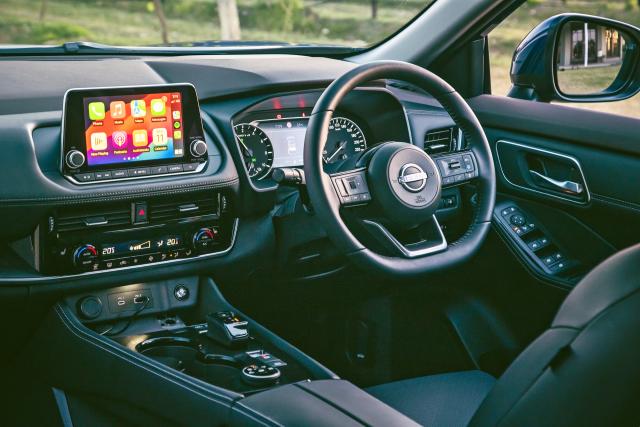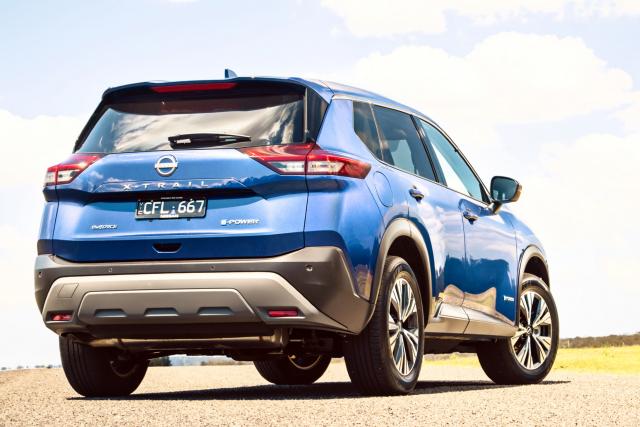The term e-POWER is Nissan’s take on hybrids.
In the case of X-Trail, it’s Nissan’s competitor for the Toyota RAV4 Hybrid, a car so popular there’s a two-year waiting list.
It’s a little different from the system offered by other manufacturers and made its debut in the medium-sized SUV at the beginning of last year.
The X-Trail ST-L e-POWER with e-4ORCE is the cheapest of the X-Trail hybrids and comes as a five-seater with all-wheel drive.
STYLING
Signature design elements such as the floating roof and V-motion grille have been enhanced by a unique grille treatment for e-POWER models.
The grille is framed by striking headlights that appear moulded within the bodywork of the front bumper, with combined daytime running lights and indicators nestled along the shut-line of the bonnet.
ST-L e-POWER with e-4ORCE is priced from $49,990 before on-road costs.
That’s from $3200 to $6300 more than its petrol-powered equivalent, but you can’t quite compare apples with apples.
The conventional five-seat petrol model is two-wheel drive, while the all-wheel drive version comes with seven seats. Gotta love those tricky marketing people.
There’s also e-Power Ti at $54,690 and the Ti-L at $57,690, also five-seaters.
ST-L e-POWER has a premium feel thanks to synthetic leather and two-zone climate air, with heated front seats, a leather-clad wheel, power-adjust driver seat and darkened rear privacy glass.
It rides on 18-inch wheels with LED head and tail lights, along with LED daytime running lights and automatic high beam, as well as auto lights and wipers and an auto-dimming rear view mirror plus auto-fold, power-adjust heated mirrors.
X-Trail comes with a five-year, unlimited kilometre warranty plus five-year roadside assistance, with service intervals pegged at 12 months or a tightish 10,000km.
INFOTAINMENT
Infotainment comes in the form of an 8.0-inch touchscreen, with Bluetooth, AM/FM and DAB+ digital radio, wired Apple CarPlay and Android Auto and six-speaker audio (but no navigation).
Ti and Ti-L get satnav, a larger 12.3-inch touchscreen and wireless charging.
There are four USB ports: USB-A and USB-C in the front and charge only USB-A and USB-C in the back, with 12-volt outlets in the front and luggage area.
ENGINES/TRANSMISSIONS
The e-POWER with e-4ORCE system is comprised of a high-output 2.1 kWh battery together with a turbocharged 1.5-litre three cylinder variable compression petrol engine, power generator, inverter and twin electric motors – 150kW for the front and 100kW for the rear (with a combined system output of 157kW).
All-wheel drive comes courtesy of front and rear electric motors, but like most SUVs it operates predominantly in two-wheel drive most of the time with drive to the front-wheels through a single-speed reduction gear.
SAFETY
Five-star safety includes seven airbags, including a centre airbag which provides added protection to front seat occupants in side impact crashes.
There’s also autonomous emergency braking (Car-to-Car, Vulnerable Road User, Junction Assist and Backover) as well as a lane support system with lane keep assist (LKA), lane departure warning (LDW) and emergency lane keeping (ELK) and an advanced speed assistance system (SAS).
A digital around view monitor provides moving object detection, with front and rear parking sensors and tyre pressure monitoring.
Without the initial start-up noise of a petrol engine, an acoustic alert system warns pedestrians that the car has begun to move.
Isofix child seat anchors are provided for the outside rear seats, as well as tethers for all three rear seats and rear seat alert prevents kids from being left behind in the car.
DRIVING
The big difference between Nissan’s hybrid and the others is that the petrol engine does not power the wheels.
No, sir. The petrol ICE is used only to produce electricity which powers the electric motors that turn the wheels.
That makes it a series hybrid, as opposed to a parallel hybrid like the Toyota Prius (sorry, forgot, they don’t do Prius anymore, at least not here).
Under heavy acceleration or when the battery is low on charge, however, the petrol engine will deliver power not just to the battery – but to the electric motors.
The beauty of this system, according to Nissan, is that the petrol engine is always able to run within its ideal rev range, not forced to lug or over-rev madly as in conventional cars.
In reality the e-Power system feels a little weird and, in our experience, makes some strange noises from time to time.
In fact, it feels more like an electric vehicle than a petrol-powered one, which it is in a way.
Thanks to drive being provided by the electric motors, Nissan says there’s no delay in acceleration as with an ICE or traditional hybrid.
The instant response delivers exhilarating acceleration to make overtaking or merging onto a motorway easier.
Again, in reality, the response isn’t quite as instantaneous or as thrilling as promised, but it is relatively brisk.
In fact, it feels faster than the claimed 7.0 seconds from 0-100km/h. However, it can deliver torque to the rear wheels when required up to 10,000 times faster than mechanical all-wheel drive.
A drive and terrain mode selector offers five different modes: Auto, Eco, Sport, Snow and Off-Road.
With a 55-litre tank, fuel consumption is a claimed 6.1L/100km using premium 95 unleaded and it generates 139g/km of CO2.
In comparison the 2.5-litre petrol version uses 7.8L/100km (of standard unleaded).
Maximum braked towing capacity is 1650kg, down 350kg on the petrol version.
It’s pretty quiet in the cabin of the X-Trail, thanks to the fact that the petrol engine doesn’t have to work hard.
For example, at 40km/h, Nissan says the sound level in the cabin is 8dB lower than competitors (it doesn’t say which).
A switch in the centre console enables one-pedal driving that slows the car as soon as the driver reduces pressure on the accelerator, slowing the car down to a creep – but not to a complete stop.
It takes the tedium out of constantly switching between brake and accelerator in stop-start city driving as well as turning corner to corner country driving into a new experience.
And, in case you’re wondering, lifting off from the accelerator activates the brake lights, warning drivers behind you.
In Sport mode with one-pedal driving selected, the e-Power X-trail feels lively and almost fun to drive.
It makes short work of hills and remains reasonably tied down in corners, albeit with a bit of tyre squeal.
ST-L misses out on a customisable, fully digitised instrument cluster, but the conventional dials are large, clear and easy to read.
It’s interesting to note that many drivers prefer to switch their digital clusters to show a pair of old-style analogue dials anyway, which makes customisation kind of superfluous.
We’re big fans of adaptive cruise control, but the current Nissan system is a struggle.
Setting the speed is easy and so is adjusting the distance to the car in front, but actually activating it is a matter of trial and error.
The gap to the car in front by the way is still too large and does not deter aggressive drivers from cutting in.
We were getting 6.8L/100km short-term which dropped to 6.4L/100km after 2000km of mixed driving.
SUMMING UP
Hmmm . . . Not quite sure what to make of the e-Power idea.
The whole point of the hybrid exercise has been as a bridging mode to full
electrification, designed to reduce fuel consumption and harmful engine emissions.
While it provides a lively drive experience, the e-Power X-Trail can’t match the RAV4 for emissions or fuel consumption, but at least it gives buyers a hybrid option and point of difference from competitors.
However, is it enough? Friends have a RAV hybrid and have been getting 5.7L/100km as regular as clockwork.
RATINGS:
Looks: 7.5
Performance: 7
Safety: 7.5
Thirst: 7
Practicality: 7
Comfort: 7.5
Tech: 7.5
Value: 7
Overall: 7.3









